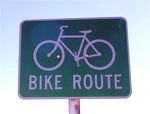Search Results
-
Sometimes Extinction is Forever
Remember that thing about the ivory-billed woodpecker—alive in the swamps of Arkansas—not extinct after all? Well, maybe not so much. In a new article in the journal Science, renown bird expert David Allen Sibley says that the evidence is insufficient and that the famous video of the bird is actually the rather common pileated woodpecker. Sibley joins Kenn Kaufman and a number of other bird experts in his assessment. In...Read more » -
Why Bikes Are a Sustainable Wonder
Two-wheeling ranks as the most energy-efficient form of travel, especially for short trips–and makes you healthier.Read more » -
Green Taxes – Highlights
The top findings from Sightline’s research on using Cascadia’s tax system to improve the region’s long-term well-being.Read more » -
Fact Sheet: The Bicycle – Seven Wonders for a Cool Planet
A bike is the most energy efficient vehicle ever created–and other cool facts about transportation.Read more » -
The Whales Among Us
The long term outlook for Puget Sound’s resident orcas depends in part on the health of the Columbia Chinook salmon, which are themselves struggling because of the four dams on the Lower Snake River. In a word: To save the whales, we may need to first save the salmon. Saving the salmon may mean tearing out the dams. And tearing out the dams would mean bridging a nasty political divide...Read more » -
Timing is Everything
One benefit of living in a compact neighborhood rather than a sprawling suburb: you don’t spend as much time in your car. The following chart, derived from a national transportation survey, makes the point pretty clearly: The bottom line: if you live in a compact place, you don’t drive as much. Of course, the total amount of time that people spend getting from place to place doesn’t vary much by...Read more » -
Principles of the State of the Union Address
I hadn’t intended to join the cacaphony of bloggers and pundits who are Monday-morning-quarterbacking the State of the Union address. But Sightline’s all-star board member, Laura Retzler, asked a great question last night that I’ve been puzzling over since: what’s Sightline’s take on Bush’s plan to end the nation’s addiction to oil? It later occurred to me—too late to answer Laura—that my reply should have been rather obvious to me....Read more » -
Food vs. Shelter: The Planning Debate
In the debate over growth management, it’s easy for the parties to forget that it’s never us against them, it’s us against us. For just one example, planners must strike a balance between our needs for food (in the form of nearby farmland) and shelter (in the form of decent housing for a growing population). And promoting density, while important in many respects, is not the whole answer to problems...Read more » -
Slim City
New studies of King County, Washington find that sprawl is linked to dirtier air and bigger bellies. Walkable neighborhoods (those places with higher residential density, more street connections, and nearby to shops, schools, and parks) appear to be healthier for residents and less damaging to air quality—even when taking into account age, income, education and ethnicity. A few key findings (liberally excerpted from the full coverage in the Seattle Times):...Read more » -
Bumper to Bumper Jumper
A few years ago, Seattle was widely known as one of the most congested cities in the country. Annual rankings by the Texas Transportation Institute placed the metro area’s traffic as one of the nation’s 5 worst—and in some years greater Seattle was ranked among the worst 3, along with places like LA and San Francisco. Then, a couple years ago the TTI changed its method of estimating congestion, largely...Read more »



